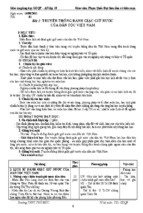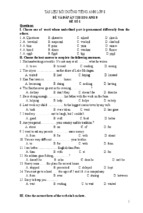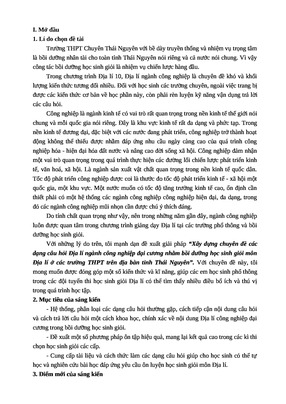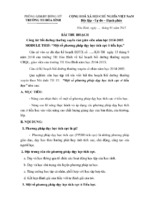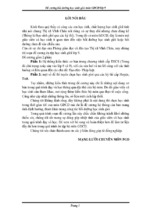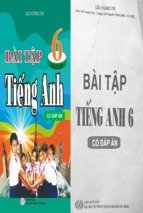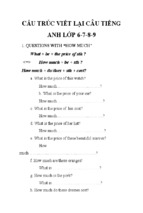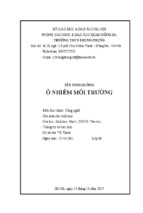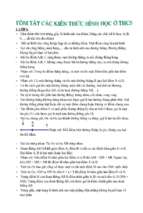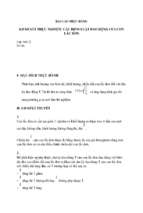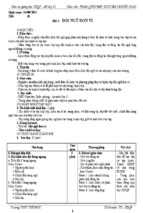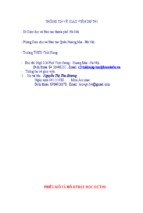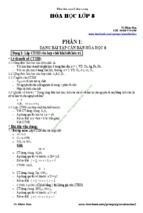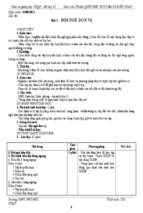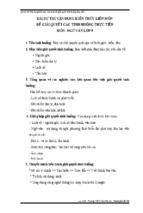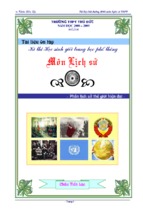READING
Read the following passage and mark the letter A, B, C, or D on your answer sheet to
indicate the correct word or phrase that best fits each of the numbered blanks from 31
to 35.
ENGLISH AROUND THE WORLD
Teaching English as a foreign language can be a great way to travel around the
world and earn money at the same time. However, some graduates actually like the idea of
(1)________a career in teaching English, and there are numerous courses at various
(2)________, from the basic certificates to the diploma or even the master’s.
To find the right course, a good place to start is TEFL.com – an Internet site with lots
of relevant information and helpful (3)________including a full list of places in the UL
offering courses. The site also offers assistance to qualified graduates (4)_______finding
work.
When deciding on a course, the best thing to do is to look at what your needs are. If
you want a career in teaching English, then definitely find one designed for that (5)_______,
such as an MA or diploma; but if you want to travel around the world, then do a shorter
course that will supply you with teaching skills.
Question 1:
A. tracking
B. chasing
C. hunting
D. following
Question 2:
A. levels
B. categories
C. groups
D. classes
Question 3:
A. opinion
B. suggestion
C. advice
D. idea
Question 4:
A. to
B. for
C. at
D. in
Question 5:
A. function
B. use
C. aim
D. purpose
Most people think that lions only come from Africa. This is understandable because
in fact most lions do come from there but this has not always been the case. If we went back
ten thousand years. we would find that there were lions roaming vast sections of the globe.
However no, unfortunately only a very small section of the lion’s former habitat remains.
Asiatic lions are sub-species of African lions. It is almost a hundred thousand years
since the Asiatic lions split off and developed as a sub-species. At one time the Asiatic lion
was living as far west as Greece and they were found from there, but in a band that spreads
east through various countries of the Middle East, all the way to India. In museums now, you
can see Greek coins that have clear images of the Asiatic lion on them. Most of them are
dated at around 500 B.C. However, Europe saw its last Asiatic lions roaming free to
thousand years ago. Over the next nineteen hundred years the numbers of Asiatic lions in
the other areas declined steadily, but it was only in the nineteenth century that they
disappeared from everywhere but in India.
The Gir Wildlife Sanctuary in India was established especially to protect the Asiatic
lion. There are now around three hundred Asiatic lions in India and almost all of them are in
this sanctuary. However, despite living in a sanctuary, which makes them safe from hunters,
they still face a number of problems that threaten their survival. One of these is the everpresent danger of disease. This is what killed more than a third of Africa’s Serengeti lions in
1994, and people are fearful that something similar could happen in the Gir Sanctuary and
kill off many of the Asiatic lions there.
India’s lions are particular vulnerable because they have a limited gene pool. The
reason for this is interesting – it is because all of them are descended from a few dozen lions
that were saved by a prince who took a particular interest in them. He was very healthy, and
he managed to protect them otherwise they would probably have died out completely.
When you see the Asiatic lion in India, what you sense is enormous vitality. They are very
impressive animals and you would never guess that they this vulnerability when you look at
them.
Question 6: According to the passage, ten thousand years ago,________.
A. lions did not live in small forests
B. lions came mainly from Afric
C. lions roamed much more than nowadays
D. there were much more lion habitats than nowadays
Question 7: The phrase “split off” in the second paragraph is closest in meaning
to________.
A. spotted animals
B. divided
C. developed into different species
D. changed the original species
Question 8: The word “vulnerable” in paragraph 4 is closest in meaning to________.
A. weak
B. careless
C. cautious
D. easily protected
Question 9: The Asiatic lion________.
A. was looking for food mainly in the Middle East
B. was searching for food in a wide range of countries
C. was searching for food mainly in India and Africa
D was looking for food mainly in India.
Question 10: According to the author, the Gir Wildlife Sanctuary________
A. protects the Asiatic lion from hunters and diseases
B. cannot reduce the Asiatic lion’s risk of catching diseases
C. can make the Asiatic lion become weak
D. is among many places where the Asiatic lion is well protected
Question 11: The author refers to all of the following as characteristics of the Asiatic lion
EXCEPT that________.
A. strong
B. vulnerable
C. vital
D. impressive
Question 12: The passage is written to________.
A. persuade readers to protect the Asiatic lions
B. explain why the Gir Sanctuary is the best habitat for the Asiatic lions
C. describe the developmental history of the Gir Sanctuary
D. provide an overview of the existence of the Asiatic lions
If you enjoy water sports, Hawaii is the place for you. You can go swimming all year
round in the warm water. You can go sport fishing from the shore or from a boat. If you like
boats, you can go sailing, canoeing, or windsurfing. Or, you can also try some other water
sports that are especially popular in Hawaii: surfing, snorkeling and scuba diving.
Surfing is a sport which started in Hawaii many years ago. The Hawaiians called it
“he’e nalu”, which means “to slide on a wave”. If you want to try surfing, you need, first of all,
to be a good swimmer. You also have to have an excellent sense of balance. You must
swim out from the beach with your surfboard under your arm. When you get to where the
waves begin to break, you wait for a calm moment. Then you try to stand up on the board.
The wave will begin to rise under you. You must try to steer the board with your feet so you
stay on top of the wave. The important thing is to keep your balance and not fall down. If you
can manage this, you will have an exciting ride all the way in to the shore.
Scuba diving and snorkeling are two ways to get a close look at the beauty lying
below the surface of the ocean. The waters off the Hawaiian Islands are clean, clear and
warm. They contain hundreds of kinds of colorful fish. The undersea world is made even
more colorful by the coral reefs of red, gold, white and light purple. Among these reefs there
may be larger fish or sea turtles.
Scuba diving allows you to see the most interesting undersea sights. “Scuba” means
“Self- contained Underwater Breathing Apparatus”, that is, equipment for breathing and
swimming around far under water. In Hawaii, you can take special courses to learn how to
scuba dive. After the courses, you can get a certificate that will allow you to dive alone.
Since it can be dangerous, proper instruction and great care are always necessary when
you are scuba diving.
If you are adventurous, you might try snorkeling instead of scuba diving. Less
equipment is needed, just a face mask, a breathing tube (snorkel) and flippers for your feet.
It only takes a few minutes to learn how to snorkel. Although you cannot dive deep into the
water, you can swim with your face below the surface. Breathing through the tube, you float
on the surface, and keep yourself moving with your flippers. Even from the surface like this,
there will be plenty of color and beauty to see.
Question 13: The passage is about ________.
A. water sports around the world
B. surfing
C. tourist activities in Hawaii
D. water sports in Hawaii
Question 14: You can infer from the passage that________.
A. water sports are all expensive
B. you need to take a course for all water sports.
C. everyone can find a way to enjoy sports in the water
D. swimming in Hawaii can be dangerous
Question 15: According to the passage, surfing________.
A. began as a sport in 1943
B. was invented by the native
Hawaiians
C. requires expensive equipment
D. is very dangerous
Question 16: The water around the Hawaiian Islands is________
A. often quite cold
B. full of colorful things to see
C. usually very dark
D. full of dangerous fish
Question 17: The word “this” in the second paragraph refers to________
A. standing on the board
B. keeping balanced and not falling down
C. an exciting ride
D. staying on top of the wave
Question 18: According to the passage, scuba diving________
A. is an ancient Hawaiian water sport
B. requires special equipment and training
C. is the only way to see the fish underwater
D. requires good balance
Question 19: The word “proper” in paragraph 4 refers to________
A. enthusiastic
B. informative
C. appropriate
D. short and clear
Question 20: Which statement is supported by the information in the passage?
A. Snorkeling involves breathing through the tube, floating on the surface and moving
with flippers
B. Snorkeling requires more expensive equipment than scuba diving
C. Snorkeling is for adventurous people
D. Snorkeling was invented in ancient times
British parents are always complaining that their children spend too much time glued to the
TV and do not have enough time on other activities (31) ________sports and reading. A
survey recently (32) ________on people’s viewing habits does not approve this. It shows
that young people in Britain spend on average 23 hours a week in front of the television, (33)
________works out at over three hours a day.
(34) ________is surprising, however, is the fact that the average adult watches even
more: an incredible 28 hours a week. We (35) ________to have become a nation of addicts.
Just about every household in the country has a television set and over half have two or
more. According to the survey, people nowadays don’t just watch television sitting in their
living-rooms, they watch it in the kitchen and in bed as well
Question 21:
A. such
B. like
C. as
D. alike
Question 22:
A. investigated
B. researched
C. carried out
D. carried
Question 23:
A. that
B. which
C. this
D. it
Question 24:
A. What
B. It
C. The thing
D. This
Question 25:
A. seem
B. ought
C. used
D. would like
Most people go to a doctor in their own town or suburbs. But people in the Australian
outback can’t get to a doctor quickly. The nearest doctor is sometimes hundreds of
kilometers away so they have to call him on a two-way radio. This special doctor is called
the “flying doctor”. He visits sick people by plane.
When someone is sick, the doctor has to fly to the person’s home. His plane lands
on a flat piece of ground near the person’s house. Sometimes the doctor has to take the
patient to hospital. Flying doctors take about 8,600 people to hospital each year.
However, most of the time the person isn’t very sick, and the doctor doesn’t have to
visit. He can give advice on the radio from the office at the flying doctor center. He can tell
the patient to use some medicine from a special medicine chest. There is one of these
chests in every home in the outback. Each bottle, tube and packet in the chest has a
number. The doctor often says something like this, “Take two tablets from bottle number 5
every four hours.”
A man called John Flynn started the Royal Flying Doctor service in 1927. He had
only one plane. Today there are 14 flying-doctor centers, 29 planes, 14 full-time doctors and
several part- time doctors, nurses and dentists.
Question 26: The flying doctors mentioned in this article treat their patients
A. in clinics
B. by old methods
C. over great distances D. by telepathy
Question 27: Which happens first?
A. The doctor flies to the sick person’s home
B. The sick person or his family calls the doctor on a two-way radio
C. The plane lands near the patient’s house
D. The doctor treats the sick person on a two-way radio
Question 28: The word “outback” mostly means________
A. a large field of the Aborigines
B. an isolated island
C. a vast and remote area
D. a far-off forest
Question 29: The word “chest” in this context probably means________
A. a body part
B. a machine
C. a remote control D. a small box
Question 30: When a patient needs a special examination, the doctor has to________
A. take him/her to a special holy place
B. fly him/her to a military clinic
C. give him/her all kinds of medicine
D. fly to the patient’s place
Question 31: All of the following statements are true EXCEPT________
A. None of the doctor at the center work full-time
B. Every home in the outback has a chest
C. Sometimes the doctor has to take the patient to hospital
D. The doctor gives prescription using specific numbers for each kind of medicine
Question 32: The writer of this passage shows a/an________attitude to the flying- doctor
service.
A. critical
B. supportive
C. curious
D. indifferent
Question 33: How has science done a disservice to people?
A. Because of science, disease caused by contaminated food has been virtually
eradicated
B. It has caused a lack of information concerning the value of food
C. As a result of scientific intervention, some potentially harmful substances have been
added to our food
D. The scientists have preserved the color of meats, but not of vegetables
Question 34: According to the passage, what are nitrates used for?
A. They preserve flavor in package foods
B. They are the objects of research
C. They preserve the color of meats
D. They cause the animals to become fatter
Question 35: The word “fit” is closest in meaning to
A. athletic
B. suitable
C. tasty
D. adaptable
Question 36: The word “these” in paragraph 2 refers to
A. meats
B. colors
C. researchers
D. nitrates and
nitrites
Question 37: The word “carcinogenic” is closest in meaning to
A. trouble-making
B. color-retaining
C. money-making
D. cancer-causing
Question 38: All the following statements are true EXCEPT
A. Drugs are always given to animals for medical reasons
B. Some of the additives in our food are added to the food itself and some are given to
the living animals
C. Researchers have known about the potential hazards of food additives for more than
45 years
D. Food may cause 40% of the cancer in the world
Question 39: The word “additives” in paragraph 3 is closest in meaning to
A. added substances
B. dangerous substances
C. natural substances
D. toxic substances
Question 40: What is the best title for this passage?
A. Harmful and harmless substances in food
B. The food you eat can affect your health
C. Improving health through a natural diet
D. Avoiding injurious substances in food
NOISE POLLUTION
Noise is more than a mere nuisance. At certain levels and durations of exposure, it
can cause physical damage to the eardrum, and (41) ________in temporary or permanent
hearing loss. In addition to causing hearing loss, (42) ________noise exposure can also (43)
________blood pressure and pulse rate, cause irritability, anxiety, and mental fatigue, and
interfere with sleep, recreation, and personal communication. Noise pollution is, therefore,
(44________importance in the workplace and in the community.
Noise effects can be (45) ________by a number of techniques, for example,
increasing the distance or blocking the path between the noise source and the recipient,
reducing noise level at the source, and protecting recipients with earplugs or earmuffs
Question 41:
A. bring
B. result
C. create
D. affect
Question 42:
A. exceedingly
B. excess
C. excessively
D. excessive
Question 43:
A. enlarge
B. maximize
C. raise
D. rise
Question 44:
A. for
B. of
C. at
D. within
Question 45:
A. minimized
B. created
C. brought
D. done
As heart disease continues to be the number-one killer in the United States,
researchers have become increasingly interested in identifying the potential risk factors
that trigger heart attacks. High-fat diets and “life in the fast lane” have long been known to
contribute to 5 the high incidence of heart failure. But according to new studies, the list of
risk factors may be significantly longer and quite surprising.
Heart failure, for example, appears to have seasonal and temporal 10 patterns. A
higher percentage of heart attacks occur in cold weather, and more people experience heart
failure on Monday than on any other day of the week. In addition, people are more
susceptible to heart attacks in the first few hours after waking. Cardiologists first observed
this morning phenomenon
in the mid-1980, and have since 15 discovered a number of possible causes. An earlymorning rise in blood pressure, heart rate, and concentration of heart stimulating hormones,
plus a reduction of blood flow to the heart, may all contribute to the higher incidence of heart
attacks between the hours of 8:00 A.M. and 10:00 A.M.
In other studies, both birthdays and bachelorhood have been implicated as risk
factors. Statistics reveal that heart attack rates increase significantly for both females and
males in the few days immediately preceding and following their birthdays. And unmarried
men are more 25 at risk for heart attacks than their married counterparts. Though stress is
thought to be linked in some way to all of the aforementioned risk factors, intense research
continues in the hope of further comprehending why and how heart failure is triggered
Question 46:What does the passage mainly discuss?
A. risk factors in heart attacks
B. seasonal and temporal patterns of heart attacks
C. cardiology in the 1980s
D. diet and stress as factors in heart attacks
Question 47: In paragraph 1, the word “potential” could best be re-placed by which of the
following?
A. harmful
B. primary
C. unknown
D. possible
Question 48: The word “trigger” as used in paragraph 1 is closest in meaning to which of
the following?
A. involve
B. affect
C. cause
D. encounter
Question 49: The phrase “susceptible to” in paragraph 2 could best be replaced by
________.
A. aware of
B. affected by
C. accustomed
D. prone to
Question 50: According to the passage, which of the following is NOT a possible cause of
many heart attacks?
A. decreased blood flow to the heart
B. increased blood presure
C. lower heart rate
D. increase in hormones
Question 51: Which of the following is NOT cited as a possible risk factor?
A. Having a birthday
B. Getting married
C. Rating fatty foods
D. Being under stress
Question 52: Which of the following does the passage infer?
A. We now fully understand how risk factors trigger heart attacks
B. We recently began to study how risk factors trigger heart attacks
C. We have not identified many risk factors associated with heart attacks
D. We do not fully understand how risk factors trigger heart attacks
Aging is the process of growing old. It occurs eventually in every living thing provided,
of course, that an illness or accident does not kill it prematurely. The most familiar outward
signs of aging may be seen in old people, such as the graying of the hair and the wrinkling of
the skin. Signs of aging in a pet dog or cat include loss of playfulness and energy, a decline
in hearing and eyesight, or even a slight graying of the coat. Plants age too, but the signs are
much harder to detect.
Most body parts grow bigger and stronger, and function more efficiently during childhood.
They reach their peak at the time of maturity, or early adulthood. After that, they begin to
decline. Bones, for example, gradually become lighter and more brittle. In the aged, the
joints between the bones also become rigid and more inflexible. This can make moving very
painful.
All the major organs of the body show signs of aging. The brain, for example, works
less efficiently, and even gets smaller in size. Thinking processes of all sorts are slowed
down. Old people often have trouble in remembering recent events.
One of the most serious changes of old age occurs in the arteries, the blood vessels that
lead from the heart. They become thickened and constricted, allowing less blood to flow to
the rest of body. This condition accounts, directly or indirectly, for many of the diseases of
the aged. It may, forexample, result in heart attack.
Aging is not a uniform process. Different parts of the body wear out at different rates.
There are great differences among people in their rate of aging. Even the cells of the body
differ in the way they age. The majority of cells are capable of reproducing themselves many
times during the course of a lifetime. Nerve cells and muscle fibers can never be replaced
once they wear out.
Gerontologists - scientists who study the process of aging-believe this wearing out of
the body is controlled by a built-in biological time-clock. They are trying to discover how this
clock works so that they can slow down the process. This could give man a longer life and a
great number of productive years.
Question 53: What is the main idea of the first paragraph?
A. Signs of aging are easier to detect in animals than in plants
B. Aging occurs in every living thing after it has reached maturity
C. Not all signs of aging are visible
D. The outward signs of aging may be seen in old people
Question 54: What does the word “it” in paragraph 1 refer to?
A. aging
B. a living thing
C. an illness
D. an accident
Question 55: When does the human body begin to lose vigor and the ability to function
efficiently?
A. Soon after reaching adulthood
B. During childhood
C. Early adulthood
D. In old age
Question 56: What happens to memorization when the brain begins to age?
A. It works less
B. It becomes forgetful
C. It declines
D. It slows down
Question 57: The word “brittle” in paragraph 2 means________
A. soft and easily bent
B. hard and endurable
C. hard but easily broken
D. rigid and inflexible
Question 58: According to the passage, what condition is responsible for many of the
diseases of the old?
A. The arteries have become thickened and constricted
B. The blood vessels lead from the heart
C. The brain gets smaller in size
D. Bones become lighter and brittle
Question 59: According to the passage, which of the following is NOT true?
A. All living things grow old
B. Aging is unavoidable in any living things
C. Plants show less signs of aging than any other living things
D. Most body parts wear out during the course of a lifetime
Question 60: What is the main idea of the last paragraph?
A. Gerontologists have controlled the process of aging
B. Gerontologists are working hard to help people live longer and more healthily
C. Gerontologists are trying to give people an eternal life
D. Gerontologists are now able to slow down the process of aging
ORESUND BRIDGE
Imagine driving along a bridge that is so long that you can't even see the other end.
The Oresund Bridge, one of the longest bridges in the world, (61)________so far ahead into
the distance that you can't even tell where the blue of the water (62) ________ the blue of
the sky.
The Oresund Bridge is an amazing example of modern engineering design that links
the Scandinavian countries of Denmark and Sweden. It is 8 kilometers long and was (63)
________in July 2000. It crosses the Flinte Channel, the chilly waterway (64) ________the
two countries.
At one stage the bridge turns into a tunnel under the sea. This tunnel is also a record
breaker in its own right as it is the longest road and rail tunnel in the world. The engineers
built an artificial island near the Danish coast that (65) ________support part of the bridge
structure, as well as being the point at which the road disappears underground, before
coming out in Copenhagen, the capital of Denmark.
Question 61:
A. travels
B. leans
C. stretches
D. pulls
Question 62:
A. comes
B. meets
C. lines
D. starts
Question 63:
A. done
B. ended
C. brought
D. completed
Question 64:
A. splitting
B. cutting
C. breaking
D. separating
Question 65:
A. helps
B. aids
C. attempts
D. tries
Mickey Mantle was one of the greatest baseball players of all time. He played for the
New York Yankees in their years of glory. From the time Mantle began to play professionally
in 1951 to his last year in 1968, baseball was the most popular game in the United States.
For many people, Mantle symbolized the hope, prosperity, and confidence of America at that
time.
Mantle was a fast and powerful player, a “switch-hitter” who could bat both righthanded and left-handed. He won game after game, one World Series championship after
another, for his team. He was a wonderful athlete, but this alone cannot explain America’s
fascination with him.
Perhaps it was because he was a handsome, red-haired country boy, the son of a
poor miner from Oklahoma. His career, from the lead mines of the West to the heights of
success and fame, was a fairy-tale version of the American dream. Or perhaps it was
because America always loves a “natural”: a person who wins without seeming to try, whose
talent appears to come from an inner grace. That was Mickey Mantle.
But like many celebrities, Mickey Mantle had a private life that was full of problems.
He played without complaint despite constant pain from injuries. He lived to fulfill his father’s
dreams and drank to forget his father’s early death.
It was a terrible addiction that finally destroyed his body. It gave him cirrhosis of the
liver and accelerated the advance of liver cancer. Even when Mickey Mantle had turned
away from his old life and warned young people not to follow his example, the destructive
process could not be stopped. Despite a liver transplant operation that had all those who
loved and admired him hoping for a recovery, Mickey Mantle died of cancer at the age of 63
Question 66: What is the main idea of the passage?
A. Mickey Mantle as the greatest baseball player of all time
B. Mickey Mantle’s success and private life full of problems
C. Mickey Mantle and his career as a baseball player
D. Mickey Mantle and the history of baseball
Question 67: According to the passage, Mantle could________
A. hit the ball to score from a long distance
B. bat better with his left hand than with his right hand
C. hit with the bat on either side of his body
D. give the most powerful hit in his team
Question 68: The word “this” as used in paragraph 2 refers to________
A. Mantle’s being a fast and powerful player
B. Mantle’s being a wonderful athlete
C. Mantle’s being fascinated by many people
D. Mantle’s being a “switch-hitter”
Question 69: The author uses the word “But” in paragraph 4 to________
A. change the topic of the passage
B. give an argument in favor of Mantle’s success and fame
C. explain how Mantle got into trouble
D. give an example of the trouble in Mantle’s private life
Question 70: The word “accelerated” in paragraph 5 is closest in meaning to________
A. worsened
B. bettered
C. delayed
D. quickened
Question 71: We can see from paragraph 5 that after his father’s death, Mantle________
A. played even better
B. forgot his father’s dream
C. . led a happier life
D. suffered a lot of pain
Question 72: Which of the following is mentioned as the main cause of the destruction of
Mantle’s body?
A. His loneliness
B. His way of life
C. His liver transplant operation
D. His own dream
Humans have struggled against weeds since the beginnings of agriculture. Marring
our gardens is one of the milder effects of weeds - any plants that thrive where they are
unwanted. They clog waterways, destroy wildlife habitats, and impede farming. Their spread
eliminates grazing areas and accounts for one-third of all crop loss. They compete for
sunlight, nutrients, and water with useful plants.
The global need for weed control had been answered mainly by the chemical
industry. Its herbicides are effective and sometimes necessary, but some pose serious
problems, particularly if misused. Toxic compounds threaten animal and public health when
they accumulate in food plants, groundwater, and drinking water. They also harm workers
who apply them.
In recent years, the chemical industry has introduced several herbicides that are
more ecologically sound. Yet new chemicals alone cannot solve the world's weed problems.
Hence, scientists are exploring the innate weed-killing powers of living organisms, primarily
insects and microorganisms.
The biological agents now in use are environmentally benign and are harmless to
humans. They can be chosen for their ability to attack selected targets and leave crops and
other plants untouched. In contrast, some of the most effective chemicals kill virtually all the
plants they come in contact with, sparing only those that are naturally resistant or have been
genetically modified for resistance. Furthermore, a number of biological agents can be
administered only once, after which no added applications are needed. Chemicals typically
must be used several times per growing season.
Question 73: With what topic does this passage primarily deal?
A. The importance of the chemical industry
B. The dangers of toxic chemicals
C. A proposal to ban the use of all herbicides
D. Advantages of biological agents over chemical ones
Question 74: The word "Marring" in paragraph 1 is closest in meaning to________
A. spoiling
B. planting
C. dividing
D. replacing
Question 75: Which of the following terms does the author define in the first paragraph?
A. weeds
B. nutrients
C. wildlife habitats
D. grazing area
Question 76: Which of the following statements about the use of chemical agents as
herbicides would the author most likely agree?
A. It is safe but inefficient
B. It is occasionally required
C. It should be increased
D. It has become more dangerous recently
Question 77: Which of the following is NOT given as an advantage of using biological
agents over chemical herbicides?
A. They are safer for workers
B. They are less likely to destroy desirable plants
C. They are more easily available
D. They do not have to be used as often
Question 78: The word "innate" in paragraph 3 is closest in meaning to________
A. effective
B. organic
C. natural
D. active
Question 79: According to the passage, biological agents mainly consist of________
A. herbicides
B. useful plants
C. weeds
D. insects and microorganisms
Question 80: Which of the following best describes the organization of the passage?
A. A general idea is introduced and several specific examples are given
B. Two possible causes of a phenomenon are compared
C. A problem is described and possible solutions are discussed
D. A recommendation is analyzed and rejected
The United States has many different types of families. While most American families are
traditional, (81) ________a father, a mother and one or more children, 22 percent of all
American families in 1998 were headed by one parent, usually a woman. In a few families in
the United States, there are no children. These (82) ________couples may believe that they
would not make good parents; they may want freedom from responsibilities of childbearing;
or, perhaps they (83) ________ physically able to have children. Other families in the United
States have one adult who is a stepparent. A stepmother or stepfather is a person who joins
a family by marrying a father or a mother.
Americans (84) ________and accept these different types of families. In the United
States people have right to privacy and Americans do not believe in telling other Americans
what type of family group they must belong to. They respect each other’s choices regarding
family groups. Families are very important (85) ________ Americans.
Question 81:
A. making of
B. consisting of
C. including of
D. containing
Question 82:
A. childish
B. childlike
C. childless
D. childhood
Question 83:
A. are not
B. can not
C. could not
D. were not
Question 84:
A. tolerate
B. refuse
C. remember
D. remind
Question 85:
A. for
B. with
C. on
D. to
Perhaps it was his own lack of adequate schooling that inspired Horace Mann to
work so hard for the important reforms in education that he accomplished. While he was still
a boy, his father and older brother died, and he became responsible for supporting his
family. Like most of the children in his town, he attended school only two or three months a
year. Later, with the help of several teachers, he was able to study law and became a
member of the Massachusetts bar, but he never forgot those early struggles.
While serving in Massachusetts legislature, he signed a historic education bill that set
up a state board of education. Without regret, he gave up his successful legal practice and
political career to become the frst secretary of the board. There he exercised an enormous
influence during the critical period of reconstruction that brought into existence the American
graded elementary school as substitute for the older distinct school system. Under his
leadership, the curriculum was restructured, the school year was increased to a minimum of
six months, and mandatory schooling was extended to age sixteen. Other important reforms
included the establishment of state normal schools for teacher training, institutes for inservice teacher education, and lyceums for adult education. He was also instrument in
improving salaries for eachers and creating school libraries.
Mann’s ideas about school reform were developed and distributed in twelve annual
reports to the state of Massachusetts that he wrote during his tenure as secretary of
education. Considered quite radical at the time, the Massachusetts reforms later served as a
model for the nation. Mann was recognized as the father of public education
Question 86: Which of the following titles would best express the main topic of the
passage?
A. The Father of American Public Education
B. Philosophy of Education
C. The Massachusetts State Board of Education.
D. Politics of Educational Institutions
Question 87: Which of the following describes Horace Mann’s early life ?
A. He attended school six months a year
B. He had to study alone, without help
C. He supported his family after his father died
D. He was an only child
Question 88: The word “struggles” in line 5 could best be replaced by
A. valuable experiences
B. happy situations
C. influential people
D. difficult times
Question 89: The word “regret” in line 7 could best be replaced by
A. consideration
B. feeling sorry
C. limitation
D. acceptance
Question 90: What did Horace Mann advocate ?
A. The state board school system
B. The district school system
C. The substitute school system
D. The graded school system
Question 91: The word “mandatory” in line 10 is closest in meaning to
A. required
B. equal
C. excellent
D. basic
Question 92: How were Mann’s educational reforms distributed ?
A. In twelve annual reports to the state of Massachusetts
B. In reports that he wrote for national distribution
C. In speeches that he made throughout the country
D. In books that could be found in school libraries
Psychologist have debated a long time about whether a child’s upbringing can give it
the ability to do outstandingly well. Some think that it is impossible to develop genius and
say that it is simply something a person is born with. Others, however , argue that the
potential for great achievement can be develop. The truth lies somewhere between these
two extremes. It seems very obvious that being born with the right qualities from gifted
parents will increase a child’s ability to do well. However, this ability will be fully realized only
with the right upbringing and opportunities. As one psychologist says, “ To have a fast car,
you need both a good engine and fuel.’’ Scientists have recently assessed intelligence,
achievement, and ability in 50 sets of identical twins that were separated shortly birth and
brought up by different parents. They found that achievement was based on intelligence, and
later influenced by the child’s environment. One case involving very intelligent twins was
quoted. One of the twins received a normal upbringing, and performed well. The other twin,
however, was brought up by extremely supportive parents and given every possible
opportunity to develop its abilities. That twin, thought starting out with the same degree of
intelligence as the other, performed even better. This case reflects the general principle of
intelligence and ability. The more favorable the environment, the more a child’s intelligence
and ability are developed.
However, there is no link between intelligence and socioeconomic level of a child’s
family. In other words, it does not matter how poor or how rich a family is , as this does not
affect the intelligence. Gifted people can not be created by supportive parents, but they can
be developed by them. One professor of music said that outstanding musicians usually
started two or three years earlier than ordinary performers, often because their parents had
recognized their ability. These musicians then needed at least ten years’ hard work and
training in order to reach the level they were capable of attaining. People who want to have
very gifted children are given the following advice:
- Marry an intelligent person.
- Allow children to follow their own interests rather than the interests of the parents.
- Start a child’s education early but avoid pushing the child too hard.
- Encourage children to play; for example, playing with musical instrument is
essential for a child who wants to become an outstanding musician.
Question 93: The upbringing of highly intelligent children requires ________.
A. an expensive education
B. good musical instruments
C. parental support and encouragement
D. wealthy and loving parents
Question 94: The word “others” used in the first paragraph refers to ________
A. other people
B. other scientists
C. other children
D. other geniuses
Question 95: When scientists studied intelligence and ability in twins, they found that
________
A. ability depends mainly on intelligence and chievement
B. intelligence and development are irrelevant to ability
C. ability depends both on intelligence and environment
D. different twins generally have different levels of ability
Question 96: Scientists chose twins for their study because
A. each twin has the same environment as his/her twin
B. they are born into the same family, hence the same upbringing
C. they have the same economic background and hence the same opportunities
D. they have the same genetic background, usually with similar intelligence
Question 97: How were great musicians different from ordinary musicians in their
development?
A. Their ability was realized at an early stage and then nurtured
B. They practice playing their instruments for many years
C. They concentrated on music to the exclusion of the other areas
D. They were exceptionally intelligent and artistic
Question 98: The writer advises that gifted children should be allowed to follow ________
A. Their own interests
B. Their parents’ interests
C. Only their interests in musical instruments
D. Only their interests in computer games
Question 99: When encourage their gifted children, parents should avoid ________
A. Pushing their children too hard
B. letting them play their own way
C. Permitting them to follow their own interests
D. Starting their education at an early age
Question 100: The remark: “ to have a fast car, you need both a good engine and fuel’’ in
the passage means that in order to become a genius, ________
A. You need to have good heath and good nourishment
B. You need intelligence and you need to develop it
C. You should try to move quickly and efficiently
D. You must nourish your brain and train your muscles hard
Nowadays people are more aware that wildlife all over the world is in (31) ________.
Many species of animals are threatened, and could easily become (32) ________ if we do
not make an effort to protect them. There are many reasons for this. In some cases animals
are hunted for their fur or for other valuable parts of their bodies. Some birds, such as
parrots, are caught (33) ________, and sold as pets. For many animals and birds, the
problem is that their habitatsthe place where they live-is disappearing. More land is used for
farm, for houses and industry, and there are fewer open spaces than there once were.
Farmers use powerful chemicals to help them grow better crops, but these chemicals pollute
the environment and (34) ________ wildlife. The most successful animals on Earth, human
beings, will soon be the only ones (35) ________ unless we can solve this problem.
Question 101:
A. threat
B. problem
C. danger
D. vanishing
Question 102:
A. disappeared
B. vanished
C. extinct
D. empty
Question 103:
A. for life
B. alive
C. lively
D. for living
Question 104:
A. spoil
B. wound
C. wrong
D. harm
Question 105:
A. left
B. over
C. staying
D. survived
Although speech is the most advanced form of communication, there are many ways
of communicating without using speech. Signals, signs, symbols, and gestures may be
found in every known culture. The basic function of signal is to impinge upon the
environment in such a way that it attracts attention, as, for example, the dots and dashes of
a telegraph circuit. Coded to refer to speech, the potential for communication is very great.
Less adaptable to the codification of words, signs also contain meaning in and of
themselves. A stop sign or a barber pole conveys meaning quickly and conveniently.
Symbols are more difficult to describe than either signals or signs because of their
intricate relationship with the receiver’s cultural perceptions. In some cultures, applauding in
a theater provides performers with an auditory symbol of approval. Gestures such as waving
and handshaking also communicate certain cultural messages.
Although signals, signs, symbols, and gestures are very useful, they do have a major
disadvantage in communication. They usually do not allow ideas to be shared without the
sender being directly adjacent to the receiver. Without an exchange of ideas, interaction
comes to a halt. As a result, means of communication intended to be used for long distances
and extended periods must be based upon speech. To radio, television, and the telephone,
one must add fax, paging systems, electronic mail, and the Internet, and no one doubts but
that there are more means of communication on the horizon.
Question 106: Which of the following would be the best title for the passage?
A. Gestures
B. Signs and signals C. Speech
D. Communication
Question 107: According to this passage, what is a signal?
A. A form of communication that interrupts the environment
B. The most difficult form of communication to describe
C. A form of communication which may be used across long distances
D. The form of communication most related to cultural perception
Question 108: The word “it” in paragraph 1 refers to________
A. way
B. environment
C. function
D. signal
Question 109: The word “intricate” in paragraph 2 could best be replaced by________
A. inefficient
B. complicated
C. historical
D. uncertain
Question 110: Applauding was cited as an example of________
A. a signal
B. a sign
C. a gesture
D. a symbol
Question 111: Why were the telephone, radio, and television invented?
A. Because people were unable to understand signs, signals, and symbols
B. Because people believed that signs, signals, and symbols were obsolete
C. Because people wanted to communicate across long distances
D. Bcause people wanted new forms of communication
Question 112: It may be concluded from this passage that .
A. Only some cultures have signs, signals, and symbols
B. Signs, signals, symbols, and gestures are forms of communication
C. Symbols are very easy to define and interrupt
D. Waving and handshaking are not related to culture
Smallpox was the first widespread disease to be eliminated by human intervention.
Known as a highly contagious viral disease, it broke out in Europe, causing the deaths of
millions of people until the vaccination was invented by Edward Jenner around 1800. In
many nations, it was a terror, a fatal disease until very recently. Its victims suffer high fever,
vomiting and painful, itchy, pustules that left scars. In villages and cities all over the world,
people were worried about suffering smallpox.
In May, 1966, the World Health Organization (WHO), an agency of the United
Nations was authorized to initiate a global campaign to eradicate smallpox. The goal was to
eliminate the disease in one decade. At the time, the disease posed a serious threat to
people in more than thirty nations. Because similar projects for malaria and yellow fever had
failed, few believed that smallpox could actually be eradicated but eleven years after the
initial organization of the campaign, no cases were reported in the field.
The strategy was not only to provide mass vaccinations but also to isolate patients
with active smallpox in order to contain the spread of the disease and to break the chain of
human transmission. Rewards for reporting smallpox assisted in motivating the public to aid
health workers. One by one, each small-pox victim was sought out, removed from contact
with others and treated. At the same time, the entire village where the victim had lived was
vaccinated.
By April of 1978 WHO officials announced that they had isolated the last known case
of the disease but health workers continued to search for new cases for additional years to
be completely sure. In May, 1980, a formal statement was made to the global community.
Today smallpox is no longer a threat to humanity. Routine vaccinations have been stopped
worldwide
Question 113: Which of the following is the best title for the passage?
A. The eradication of smallpox
B. The World Health Organization
C. Infectious disease
D. Smallpox vaccinations
Question 114: The word “contagious” is closest in meaning to________.
A. courteous
B. arresting
C. numerous
D. catching
Question 115: The global community considered the smallpox________
A. a minor illness
B. a deadly illness
C. a mental illness
D. a rare illness
Question 116: The word “threat” in paragraph 2 could best be replaced by________
A. risk
B. debate
C. announce
D. bother
Question 117: According to the passage, what way was used to eliminate the spread of
smallpox?
A. Vaccination of entire villages
B. Treatment of individual victims
C. Isolation of victims and mass vaccinations D. Extensive reporting of outbreaks
Question 118: How was the public motivated to help the health workers?
A. By educating them
B. By rewarding them for reporting smallpox cases
C. By isolating them from others
D. By giving them vaccinations
Question 119: Which one of the statements doesn’t refer to smallpox?
A. Previous project had failed
B. People are no longer vaccinated for it
C. The WHO set up a worldwide campaign to eradicate the disease
D. It was a fatal threat
Question 120: It can be inferred from the passage that________
A. yellow fever have been reported this year
B. no new cases of smallpox have been reported this year
C. smallpox victims no longer die when they contact the disease
D. smallpox is not transmitted from one person to another
The first question we might ask is: What can you learn in college that will help you in being
an employee? The schools teach a (121) __________ many things of value to the future
accountant, doctor or electrician. Do they also teach anything of value to the future
employee? The answer is: “Yes - they teach the one thing that it is perhaps most valuable
for the future employee to know. But very few students bother (122)___________ it. This
one basic skill is the ability to organize and express ideas in writing and in speaking. This
means that your success as an employee will depend on your ability to communicate with
people and to (123)___________ your own thoughts and ideas to them so they will
(124)___________ understand what you are driving at and be persuaded.
Of course, skill in expression is not enough (125)___________ itself. You must have
something to say in the first place. The effectiveness of your job depends as much on your
ability to make other people understand your work as it does on the quality of the work itself.
Question 121:
A. large
B. great
C. far
D. lots
Question 122:
A. to learning
B. with learning C. to learn
D. learn
Question 123:
A. interpret
B. give out
C. transfer
D. present
Question 124:
A. both
B. not
C. as well
D. either
Question 125:
A. on
B. for
C. by
D. in
The Census Counts!
Every ten years there is a national census to count the number of people. The
census counts the number of people in each area, the number of men and women, their
ages, their profession, their family size and status. The census is the only way to count
everyone. Its results are used by a great many people and are available to everyone. The
census is useful; it helps to work out present and future needs for housing by seeing how
many people are housed now, or the sizes and ages of their families. In addition, the size of
annual grants made by the Government to public services depends largely on the numbers
and needs of people in the area provided by the census. Furthermore, the census shows
how many people have moved from one area to another and how the number of the local
work force is changing.
The census is taken in order to provide the figures about the nation as a whole. It
does not give information about any named person, family or household. Therefore, names
and addresses are needed on the forms but they are not fed into the computer. After the
census, the forms with the names on are locked away and will not be released to anyone
outside the Census Office for 100 years. The answers people give on their census forms will
be treated in strict confidence. Everyone working on the census is sworn to secrecy and can
be sued if he or she improperly reveals information
Question 126: Which of the following does the census not take interest in?
A. How many houses you have
B. How old you are
C. What your job is
D. How big your family is
Question 127: Census results________
A. are not used for anyone
B. are kept in secret forever
C. can be used for everyone
D. are used by no one
Question 128: How the size of grants to local services is based on information from the
census?
A. completely
B. very much
C. a little
D. not at all
Question 129: Which of the following statement is NOT true?
A. There are names and age on the census forms
B. The census reveals everyone’s personal information
C. People must supply personal information
D. The census information is stored in a computer
Question 130: Which of the following is true about the information of names and addresses
in the census?
A. It is stored in the computer for 100 years.
B. It is not usually correct
C. It will not be seen by anyone.
D. It will be made public after 100 years
Question 131: The word “sued” in the last sentence is closest in meaning to________
A. legally sewn
B. legally sound
C. legally punished D. legally fine
Question 132: The word “counts” in the title means________
A. is important
B. the counting
C. accounting
D. to count people
Quite different from storm surges are the giant sea waves called tsunamis, which
derive their name from the Japanese expression for “high water in a harbor.” These waves
are also referred to by the general public as tidal waves, although they have relatively little to
do with tides. Scientists often referred to them as seismic sea waves, far more appropriate in
that they do result from undersea seismic activity.
Tsunamis are caused when the sea bottom suddenly moves, during an underwater
earthquake or volcano for example, and the water above the moving earth is suddenly
displaced. This sudden shift of water sets off a series of waves. These waves can travel
great distances at speeds close to 700 kilometers per hour. In the open ocean, tsunamis
have little noticeable amplitude, often no more than one or two meters. It is when they hit the
shallow waters near the coast that they increase in height, possibly up to 40 meters.
Tsunamis often occur in the Pacific because the Pacific is an area of heavy seismic
activity. Two areas of the Pacific well accustomed to the threat of tsunamis are Japan and
Hawaii. Because the seismic activity that causes tsunamis in Japan often occurs on the
ocean bottom quite close to the islands, the tsunamis that hit Japan often come with little
warning and can, therefore, prove disastrous. Most of the tsunamis that hit the Hawaiian
Islands, however, originate thousands of miles away near the coast of Alaska, so these
tsunamis have a much greater distance to travel and the inhabitants of Hawaii generally
have time for warning of their imminent arrival.
Tsunamis are certainly not limited to Japan and Hawaii. In 1755, Europe experienced
a calamitous tsunami, when movement along the fault lines near the Azores caused a
massive tsunami to sweep onto the Portuguese coast and flood the heavily populated area
around Lisbon. The greatest tsunami on record occurred on the other side of the world in
1883 when the Krakatoa volcano underwent a massive explosion, sending waves more than
30 meters high onto nearby Indonesian islands; the tsunami from this volcano actually
traveled around the world and was witnessed as far away as the English Channel
Question 133: The paragraph preceding this passage most probably discusses?
A. underwater earthquakes
B. storm surges
C. tides
D. tidal waves
Question 134: According to the passage, all of the following are true about tidal waves
EXCEPT that________
A. they are caused by sudden changes in high and low tides
B. this terminology is not used by the scientific community
C. they are the same as tsunamis
D. they refer to the same phenomenon as seismic sea waves
Question 135: It can be inferred from the passage that tsunamis________
A. cause severe damage in the middle of the ocean
B. generally reach heights greater than 40 meters
C. are far more dangerous on the coast than in the open ocean
D. are often identified by ships on the ocean
Question 136: A main difference between tsunamis in Japan and in Hawaii is that tsunamis
in Japan are more likely to________
A. come from greater distances
B. originate in Alaska
C. be less of a problem
D. arrive without warning
Question 137: The possessive “their” in paragraph 3 refers to________
A. the Hawaiian Islands
B. thousands of miles
C. these tsunamis
D. the inhabitants of Hawaii
Question 138: A “calamitous” tsunami, in paragraph 4, is one that is________
A. at fault
B. disastrous
C. extremely calm
D. expected
Question 139: From the expression “on record” in the last paragraph, it can be inferred that
the tsunami that accompanied the Krakatoa volcano________
A. was not as strong as the tsunami in Lisbon
B. might not be the greatest tsunami ever
C. was filmed as it was happening
D. occurred before efficient records were kept
Question 140: The passage suggests that the tsunami resulting from the Krakatoa volcano
A. was far more destructive close to the source than far away
B. resulted in little damage
C. was unobserved outside of the Indonesian islands
D. caused volcanic explosions in the English Channel
Public awareness of the value of recycling materials such (141)___________ plastic, paper,
and glass is increasing daily in all corners of the globe. In some countries these efforts are
being (142)___________ by the local governments and in others, by individuals.
Participation in these programs is at an all-time high. In the small town of Truro in eastern
Massachusetts, for example, space in the local landfill has run out; therefore, residents have
had to think of new ways to (143)___________ of their trash. With no room for items such as
newspaper, bottles, and old lumber at the land fill, local residents have come up with many
(144)___________ programs to recycle and/ or reuse what was once thought of as only
trash. For instance, yard waste such as leaves and grass which used to be thrown in the
- Xem thêm -


